Petrography, Geochemistry and Mineralogy of Serpentinite Rocks Exploited in the Ophiolite Units at the Calabria-Basilicata Boundary, Southern Apennine (Italy)
Abstract
:1. Introduction
2. Geological Framework
3. Sampling and Methods
4. Results
4.1. Petrography
4.2. µ-Raman Spectroscopy
4.3. XRPD Assessment
4.4. Mineral Chemistry
4.5. Bulk Geochemistry: Major and Trace Elements
5. Discussion and Conclusions
Author Contributions
Funding
Data Availability Statement
Conflicts of Interest
References
- Stüwe, K.; Sandiford, M. A description of metamorphic PTt paths with implications for low-P high-T metamorphism. Phys. Earth Planet. Inter. 1995, 3–4, 211. [Google Scholar] [CrossRef]
- Barbieri, M.; Masi, U.; Tolomeo, L. Stable isotope evidence for a marine origin of ophicalcites from the north-central Apennines (Italy). Mar. Geol. 1979, 30, 193–204. [Google Scholar] [CrossRef]
- Lemoine, M. Serpentinites, gabbros and ophicalcites in the Piemont-Ligurian domain of the Western Alps; possible indicators of oceanic fracture zones and of associated serpentinite protrusions in the Jurassic-Cretaceous Tethys. Arch. Sci. 1980, 33, 103–115. [Google Scholar]
- Weissert, H.J.; Bernoulli, D. A transform margin in the Mesozoic Tethys: Evidence from the Swiss Alps. Geol. Runds. 1985, 74, 665–679. [Google Scholar] [CrossRef]
- Früh-Green, G.L.; Weissert, H.; Bernoulli, D. A multiple fluid history recorded in Alpine ophiolites. J. Geol. Soc. 1990, 147, 959–970. [Google Scholar] [CrossRef]
- Desmurs, L.; Manatschal, G.; Bernoulli, D. The Steinmann Trinity Revisited: Mantle Exhumation and Magmatism along an Ocean-continent Transition: The Platta Nappe, Eastern Switzerland. In Non-Volcanic Rifting of Continental Margins: A Comparison of Evidence from Land and Sea; Wilson, R.C.L., Whitmarsh, R.B., Taylor, B., Froitzheim, N., Eds.; Geological Society of London: London, UK, 2001; Volume 187, pp. 235–266. [Google Scholar]
- Kelley, D.S.; Karson, J.A.; Früh-Green, G.L.; Yoerger, D.R.; Shank, T.M.; Butterfield, D.A.; Hayes, J.M.; Schrenk, M.O.; Olson, E.J.; Proskurowski, G.; et al. A Serpentinite-Hosted Ecosystem: The Lost City Hydrothermal Field. Science 2005, 307, 1428–1434. [Google Scholar] [CrossRef]
- Ludwig, K.A.; Kelley, D.S.; Butterfield, D.A.; Nelson, B.K.; Früh-Green, G. Formation and evolution of carbonate chimneys at the Lost City Hydrothermal Field. Geochim. Cosmochim. Acta 2006, 70, 3625–3645. [Google Scholar] [CrossRef]
- Früh-Green, G.L.; Connolly, J.A.; Plas, A.; Kelley, D.S.; Grobéty, B. Serpentinization of oceanic peridotites: Implications for geochemical cycles and biological activity. Subseafloor Biosph. Mid-Ocean. Ridges 2004, 144, 119–136. [Google Scholar]
- Boschi, C.; Dini, A.; Früh-Green, G.L.; Kelley, D.S. Isotopic and element exchange during serpentinization and metasomatism at the Atlantis Massif (MAR 30 N): Insights from B and Sr isotope data. Geochim. Cosmochim. Acta 2008, 72, 1801–1823. [Google Scholar] [CrossRef]
- Kerrick, D. Serpentinite seduction. Science 2002, 298, 1344–1345. [Google Scholar] [CrossRef]
- Pereira, D.; Yenes, M.; Sánche, J.; Moreno, M. Characterization of serpentinites to define their appropriate use as dimension stone. Geol. Soc. Lond. Spec. Publ. 2007, 271, 55–62. [Google Scholar] [CrossRef]
- Pereira, D.; López, A.J.; Ramil, A.; Bloise, A. The importance of prevention when working with hazardous materials in the case of serpentinite and asbestos when cleaning monuments for restoration. Appl. Sci. 2023, 13, 43. [Google Scholar] [CrossRef]
- Melfos, V. Green Thessalian stone: The byzantine quarries and the use of a unique architectural material from the Larisa area, Greece. Petrographic and geochemical characterization. Oxf. J. Archaeol. 2008, 27, 387–405. [Google Scholar] [CrossRef]
- Pereira, D. A report on serpentinites in the context of heritage stone resources. Episodes 2012, 35, 478–480. [Google Scholar] [CrossRef] [PubMed]
- Cavallo, A.; Rimoldi, B. Chrysotile asbestos in serpentinite quarries: A case study in Valmalenco, Central Alps, Northern Italy. Environ. Sci. Process. Impacts 2013, 15, 1341–1350. [Google Scholar] [CrossRef] [PubMed]
- Cavallo, A. Serpentinitic waste materials from the dimension stone industry: Characterization, possible reuses and critical issues. Resour. Policy 2018, 59, 17–23. [Google Scholar] [CrossRef]
- Cavallo, A. Serpentino della Valmalenco (Central Alps, Northern Italy): A green dimension stone with outstanding properties. Resour. Policy 2022, 75, 102467. [Google Scholar] [CrossRef]
- Punturo, R.; Cirrincione, R.; Pappalardo, G.; Mineo, S.; Fazio, E.; Bloise, A. Preliminary laboratory characterization of serpentinite rocks from Calabria (southern Italy) employed as stone material. J. Mediterr. Earth Sci. 2018, 10, 79–87. [Google Scholar]
- Nespereira, J.; Navarro, R.; Monterrubio, S.; Yenes, M.; Pereira, D. Serpentinite from Moeche (Galicia, Northwestern Spain). A stone used for centuries in the construction of the architectural heritage of the region. Sustainability 2019, 11, 2700. [Google Scholar] [CrossRef]
- Fratini, F.; Rescic, S.; Pittaluga, D. Serpentinite and ophicalcite in the architecture of eastern Liguria and as decoration of Tuscan religious buildings. Resour. Policy 2022, 75, 102505. [Google Scholar] [CrossRef]
- Faraj, R.Q. Evaluation of the Waras Serpentinite Rocks for Dimension Stone, Mawat Ophiolite Complex, Kurdistan Region, NE Iraq. Tikrit J. Pure Sci. 2023, 27, 43–50. [Google Scholar] [CrossRef]
- Punturo, R.; Bloise, A.; Critelli, T.; Catalano, M.; Fazio, E.; Apollaro, C. Environmental implications related to natural asbestos occurrences in the ophiolites of the Gimigliano-Mount Reventino Unit (Calabria, southern Italy). Int. J. Environ. Res. 2015, 9, 405–418. [Google Scholar]
- Bloise, A.; Critelli, T.; Catalano, M.; Apollaro, C.; Miriello, D.; Croce, A.; Barrese, E.; Liberi, F.; Piluso, E.; Rinaudo, C.; et al. Asbestos and other fibrous minerals contained in the serpentinites of the Gimigliano-Mount Reventino Unit (Calabria, S-Italy). Environ. Earth Sci. 2014, 71, 3773–3786. [Google Scholar] [CrossRef]
- Bloise, A.; Catalano, M.; Critelli, T.; Apollaro, C.; Miriello, D. Naturally occurring asbestos: Potential for human exposure, San Severino Lucano (Basilicata, southern Italy). Environ. Earth Sci. 2017, 76, 1–13. [Google Scholar] [CrossRef]
- Dichicco, M.C.; Castiñeiras, P.; Galindo Francisco, C.; González Acebrón, L.; Grassa, F.; Laurita, S.; Paternoster, M.; Rizzo, G.; Sinisi, R.; Mongelli, G. Genesis of carbonate-rich veins in the serpentinites at the Calabria-Lucania boundary (southern Apennines). Rend. Online Soc. Geol. 2018, 44, 143–149. [Google Scholar] [CrossRef]
- Dichicco, M.C.; Paternoster, M.; Rizzo, G.; Sinisi, R. Mineralogical asbestos assessment in the southern Apennines (Italy): A review. Fibers 2019, 7, 24. [Google Scholar] [CrossRef]
- Bloise, A.; Ricchiuti, C.; Giorno, E.; Fuoco, I.; Zumpano, P.; Miriello, D.; Apollaro, C.; Crispini, A.; De Rosa, R.; Punturo, R. Assessment of naturally occurring asbestos in the area of Episcopia (Lucania, Southern Italy). Fibers 2019, 7, 45. [Google Scholar] [CrossRef]
- Rizzo, G.; Dichicco, M.C.; Castiñeiras, P.; Grassa, F.; Laurita, S.; Paternoster, M.; Sinisi, R.; Mongelli, G. An Integrated Study of the Serpentinite-Hosted Hydrothermal System in the Pollino Massif (Southern Apennines, Italy). Minerals 2020, 10, 127. [Google Scholar] [CrossRef]
- Ricchiuti, C.; Pereira, D.; Punturo, R.; Giorno, E.; Miriello, D.; Bloise, A. Hazardous elements in asbestos tremolite from the Basilicata region, southern Italy: A first step. Fibers 2021, 9, 47. [Google Scholar] [CrossRef]
- Cavalcante, F.; Belviso, C.; Finizio, F.; Lettino, A.; Fiore, S. Geological Map of Liguride Unit Area of the Pollino (Basilicata Region): New Data Geological, Mineralogical and Petrographic; Fiore, S., Ed.; Digilabs: Bari, Italy, 2009; ISBN 978-88-7522-026-6. [Google Scholar]
- Knott, S.D. The Liguride Complex of Southern Italy—A Cretaceous to Paleogene accretionary wedge. Tectonophysics 1987, 142, 217–226. [Google Scholar] [CrossRef]
- Monaco, C.; Tortorici, L. Tectonic role of ophiolite-bearing terrains in the development of the Southern Apennines orogenic belt. Terra Nova 1995, 7, 153–160. [Google Scholar] [CrossRef]
- Tortorici, L.; Catalano, S.; Monaco, C. Ophiolite-bearing mélanges in southern Italy. Geol. J. 2009, 44, 153–166. [Google Scholar] [CrossRef]
- Critelli, S.; Le Pera, E. Post-Oligocene sediment-dispersal system and unroofing history of the Calabrian microplate, Italy. Int. Geol. Rev. 2009, 40, 609–637. [Google Scholar] [CrossRef]
- Liberi, F.; Morten, L.; Piluso, E. Geodynamic significance of ophiolites within the Calabrian Arc. Island Arc. 2006, 15, 26–43. [Google Scholar] [CrossRef]
- Spadea, P. I carbonati delle rocce metacalcaree della Formazione del Frido della Lucania. Ofioliti 1976, 1, 431–465. [Google Scholar]
- Laurita, S.; Cavalcante, F.; Belviso, C.; Prosser, G. The Liguride Complex of the Pollino area (southern Apennines): Tectonic setting and preliminary mineralogical data. Rend. Online Soc. Geol. 2008, 2, 1–3. [Google Scholar]
- Sansone, M.T.C.; Prosser, G.; Rizzo, G.; Tartarotti, P. Spinel peridotites of the Frido unit ophiolites (southern Apennines Italy): Evidence for oceanic evolution. Period. Mineral. 2012, 81, 35–59. [Google Scholar]
- Cirrincione, R.; Fazio, E.; Fiannacca, P.; Ortolano, G.; Pezzino, A.; Punturo, R. The Calabria-Peloritani Orogen, a composite terrane in Central Mediterranean; its overall architecture and geodynamic significance for a pre-Alpine scenario around the Tethyan basin. Period. Mineral. 2015, 84, 701–749. [Google Scholar]
- Sansone, M.T.C.; Rizzo, G. Pumpellyite veins in the metadolerite of the Frido unit (southern Apennines-Italy). Period. Mineral. 2012, 81, 75–92. [Google Scholar]
- Dichicco, M.C.; Laurita, S.; Paternoster, M.; Rizzo, G.; Sinisi, R.; Mongelli, G. Serpentinite Carbonation for CO2 Sequestration in the Southern Apennines: Preliminary Study. Energy Procedia 2015, 76, 477–486. [Google Scholar] [CrossRef]
- Rizzo, G.; Buccione, R.; Paternoster, G.; Laurita, S.; Bloise, L.; Calabrese, E.; Sinisi, R.; Mongelli, G. Geochemistry and petrology of leucocratic rocks in the ophiolites from the Pollino Massif (Southern Italy): Origin and tectonic significance. Minerals 2021, 11, 1264. [Google Scholar] [CrossRef]
- Boskabadi, A.; Pitcairn, I.K.; Broman, C.; Boyce, A.; Teagle, D.A.; Cooper, M.J.; Azer, M.K.; Stern, R.J.; Mohamed, F.H.; Majka, J. Carbonate alteration of ophiolitic rocks in the Arabian–Nubian Shield of Egypt: Sources and compositions of the carbonating fluid and implications for the formation of Au deposits. Int. Geol. Rev. 2017, 59, 391–419. [Google Scholar] [CrossRef]
- Mongelli, G.; Cullers, R.L.; Dinelli, E.; Rottura, A. Elemental mobility during the weathering of exposed lower crust: The kinzigitic paragneisses from the Serre, Calabria, southern Italy. Terra Nova 1998, 10, 190–195. [Google Scholar] [CrossRef]
- Punturo, R.; Ricchiuti, C.; Bloise, A. Assessment of serpentine group minerals in soils: A case study from the village of San Severino Lucano (Basilicata, Southern Italy). Fibers 2019, 7, 18. [Google Scholar] [CrossRef]
- Barnes, I.; O’Neil, J.R. The relationship between fluids in some fresh alpine-type ultramafics and possible modern serpentinization, Western United States. Geol. Soc. Am. Bull. 1969, 80, 1947–1960. [Google Scholar] [CrossRef]
- Neal, C.; Stanger, G. Hydrogen generation from mantle source rocks in Oman. Earth Planet. Sci. Lett. 1983, 66, 315–320. [Google Scholar] [CrossRef]
- Papastamaki, A. The alkalinity and the chemical composition of springs issuing from peridotites. Ann. Géol. Des. Pays. Hell. 1977, 28, 551–556. [Google Scholar]
- Robles-Camacho, J.; Armienta, M.A. Natural chromium contamination of groundwater at León Valley, México. J. Geochem. Explor. 2000, 68, 167–181. [Google Scholar] [CrossRef]
- Goyer, R.A. Results of lead research: Prenatal exposure and neurological consequences. Environ. Health Perspect. 1996, 104, 1050–1054. [Google Scholar] [CrossRef]
- Katz, S.A.; Salem, H. The toxicology of chromium with respect to its chemical speciation: A review. J. Appl. Toxicol. 1993, 13, 217–224. [Google Scholar] [CrossRef]
- Kortenkamp, A.; Casadevall, M.; Faux, S.P.; Jenner, A.; Shayer, R.O.; Woodbridge, N.; O’Brien, P. A role for molecular oxygen in the formation of DNA damage during the reduction of the carcinogen chromium (VI) by glutathione. Arch. Biochem. Biophys. 1996, 329, 199–207. [Google Scholar] [CrossRef]
- Bartlett, R.; James, B. Behavior of chromium in soils: III. Oxidation. American Society of Agronomy. Crop Sci. Soc. Am. Soil Sci. Soc. Am. 1979, 8, 31–35. [Google Scholar]
- Eary, L.E.; Rai, D. Kinetics of chromium (III) oxidation to chromium (VI) by reaction with manganese dioxide. Environ. Sci. Technol. 1987, 21, 1187–1193. [Google Scholar] [CrossRef]
- Fendorf, S.E. Surface reactions of chromium in soils and waters. Geoderma 1995, 67, 55–71. [Google Scholar] [CrossRef]
- Oze, C.; Fendorf, S.; Bird, D.K.; Coleman, R.G. Chromium geochemistry in serpentinized ultramafic rocks and serpentine soils from the Franciscan complex of California. Am. J. Sci. 2004, 304, 67–101. [Google Scholar] [CrossRef]
- Wittbrodt, P.R.; Palmer, C.D. Reduction of Cr (VI) in the presence of excess soil fulvic acid. Environ. Sci. Technol. 1995, 29, 255–263. [Google Scholar] [CrossRef]
- Wittbrodt, P.R.; Palmer, C.D. Effect of temperature, ionic strength, background electrolytes, and Fe (III) on the reduction of hexavalent chromium by soil humic substances. Environ. Sci. Technol. 1996, 30, 2470–2477. [Google Scholar] [CrossRef]
- Decreto Legislativo 3 Aprile 2006, n. 152, Norme in Materia Ambientale, 2006. Available online: https://www.normattiva.it/uri-res/N2Ls?urn:nir:stato:decreto.legislativo:2006-04-03;152 (accessed on 3 April 2006).
- Kierczak, J.; Neel, C.; Bril, H.; Puziewicz, J. Effect of mineralogy and pedoclimatic variations on Ni and Cr distribution in serpentine soils under temperate climate. Geoderma 2007, 142, 165–177. [Google Scholar] [CrossRef]
- Oze, C.; Bird, D.K.; Fendorf, S. Genesis of hexavalent chromium from natural sources in soil and groundwater. Proc. Natl. Acad. Sci. USA 2007, 104, 6544–6549. [Google Scholar] [CrossRef]
- Boccia, P.; Meconi, C.; Sturchio, E.; Margiotta, S.; Ragone, P.; Summa, V. Natural geochemical risk in the Pollino Massif: A case-study of chromium. In Proceedings of the ICAW 2015—11th International Comet Assay Workshop, Antwerpen, Belgium, 1–4 September 2015; Volume 115, pp. 1–12. [Google Scholar]
- Margiotta, S.; Mongelli, G.; Summa, V.; Paternoster, M.; Fiore, S. Trace element distribution and Cr(VI) speciation in Ca-HCO3 and Mg-HCO3 spring waters from the northern sector of the Pollino massif, southern Italy. J. Geochem. Explor. 2012, 115, 1–12. [Google Scholar] [CrossRef]
- Summa, V.; Boccia, P.; Lettino, A.; Margiotta, S.; Palma, A.; Ragone, P.P.; Sinisi, R.; Zanellato, M.; Sturchio, E. Mobility of trace metals in serpentinite-derived soils of the Pollino Massif (Southern Italy): Insights on bioavailability and toxicity. Environ. Geochem. Health 2020, 42, 2215–2232. [Google Scholar] [CrossRef] [PubMed]
- IARC Monographs Programme on the Evaluation of the Carcinogenic Risk of Chemicals to Humans. In Some Industrial Chemicals; World Health Organization International Agency for Research on Cancer: Lyon, France, 2000; Volume 77, p. 563.
- World Health Organization. Cancer Pain Relief; World Health Organization: Geneva, Switzerland, 1986; p. 74. ISBN 92-4-156100-9. [Google Scholar]
- DM 18/03/2003 Regolamento per la Realizzazione di una Mappatura delle Zone del Territorio Nazionale Interessate Dalla Presenza di Amianto, ai Sensi Dell’articolo 20 della Legge 23 Marzo 2001, n. 93, 2003. Available online: https://www.google.com/url?sa=t&rct=j&q=&esrc=s&source=web&cd=&ved=2ahUKEwjBocnk7b-BAxUI0GEKHZ1WACcQFnoECA0QAQ&url=https%3A%2F%2Fwww.sardegnasalute.it%2Fdocumenti%2F9_463_20150211095806.pdf&usg=AOvVaw0z5No6NE0rZWrqG-rSueWP&opi=89978449 (accessed on 1 August 2023).
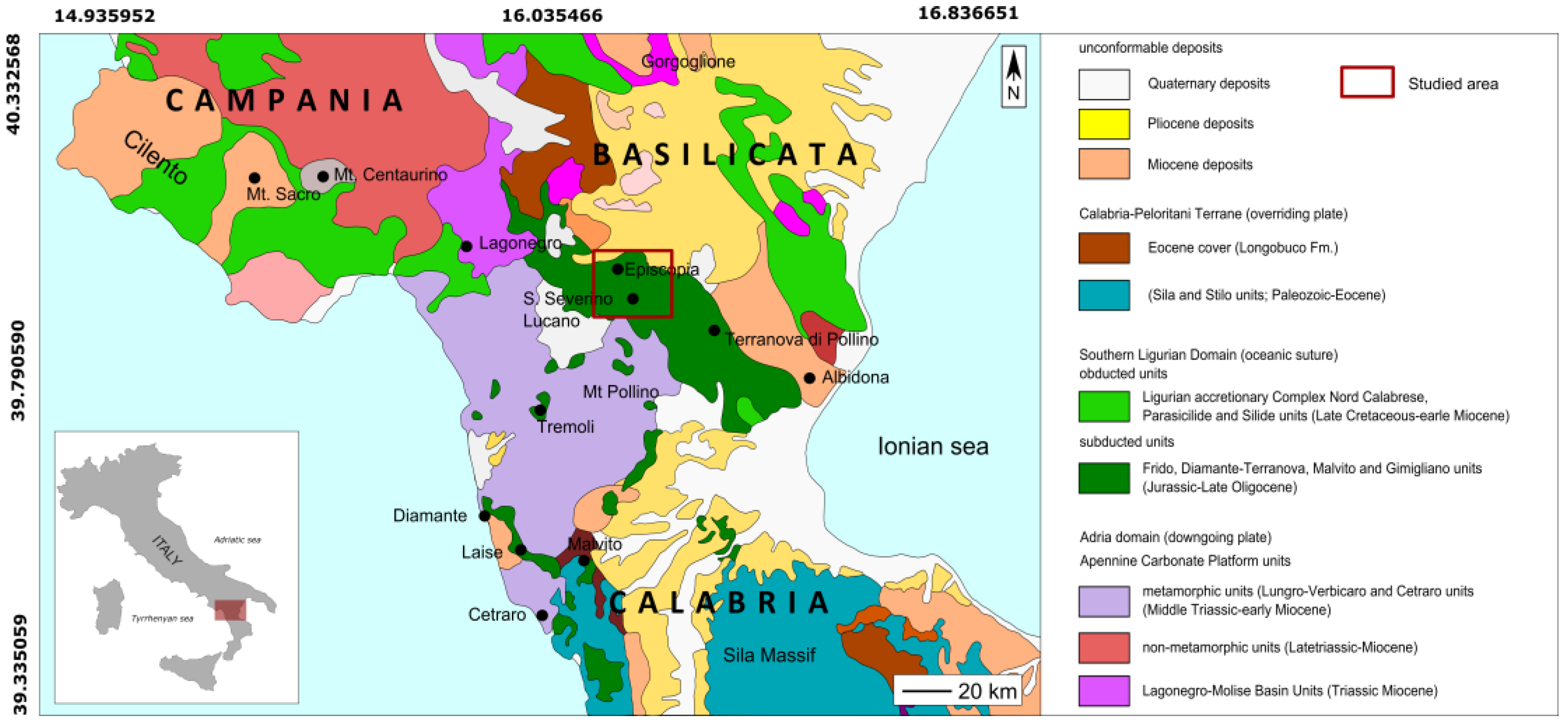
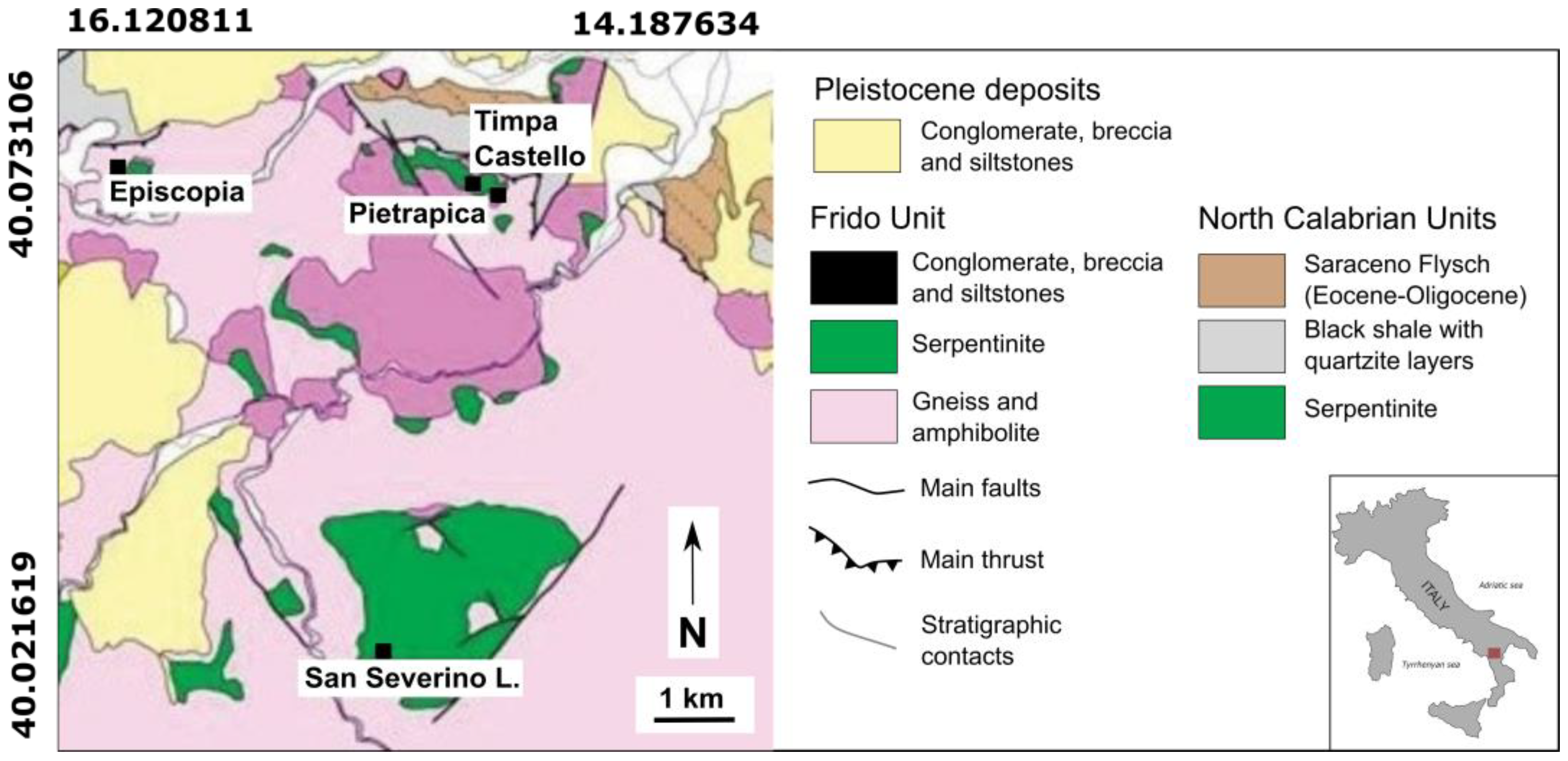
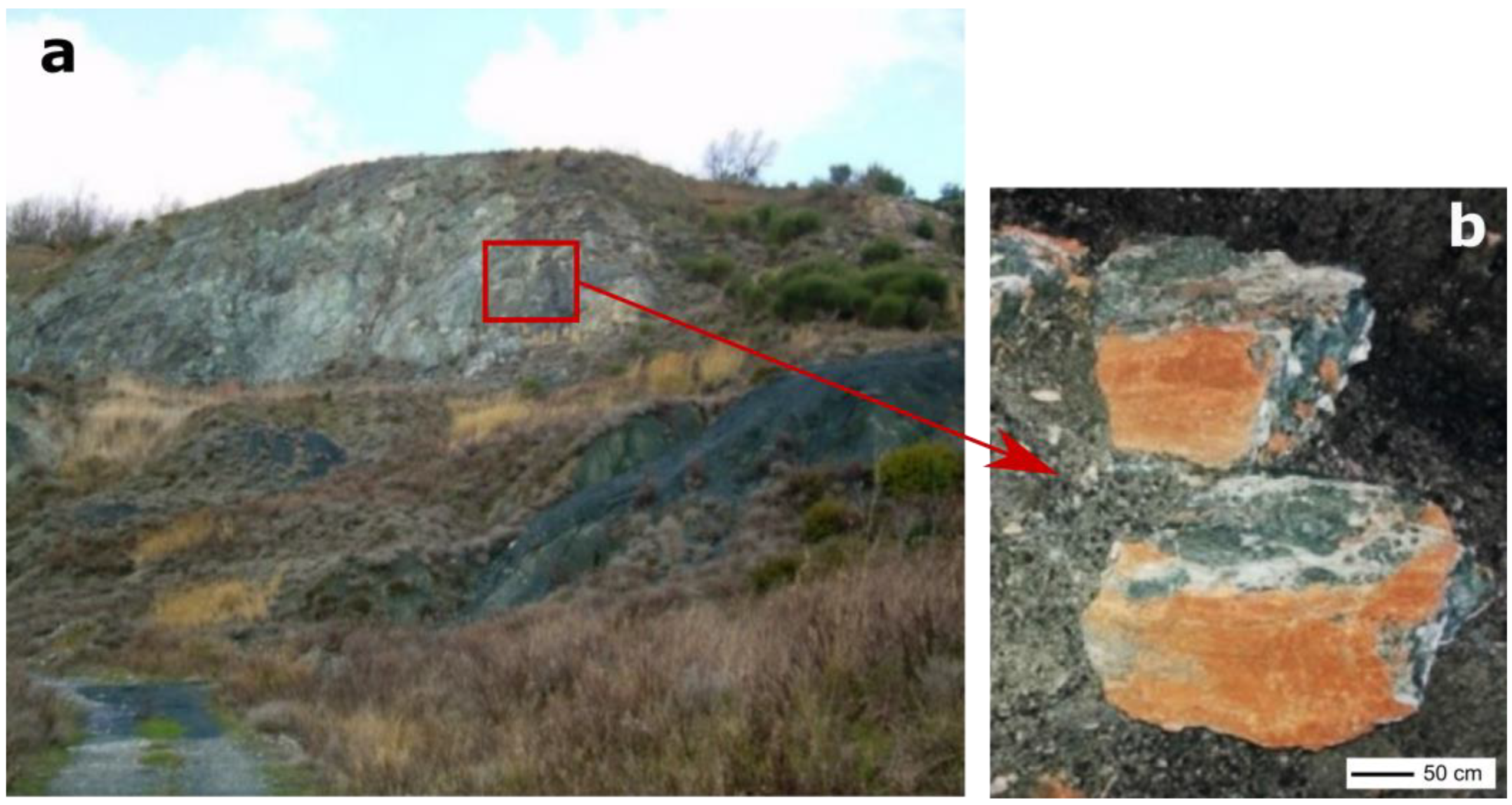
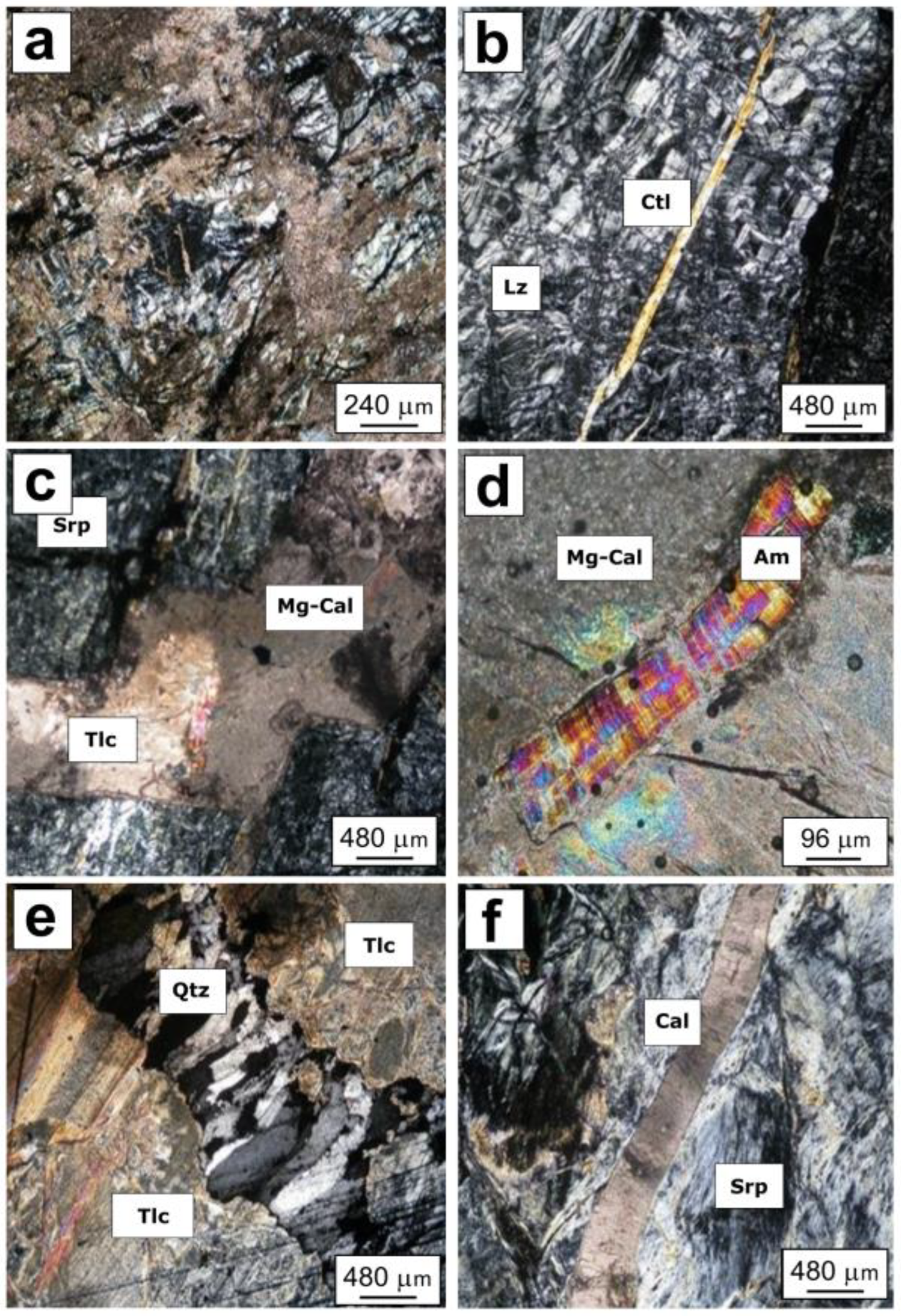
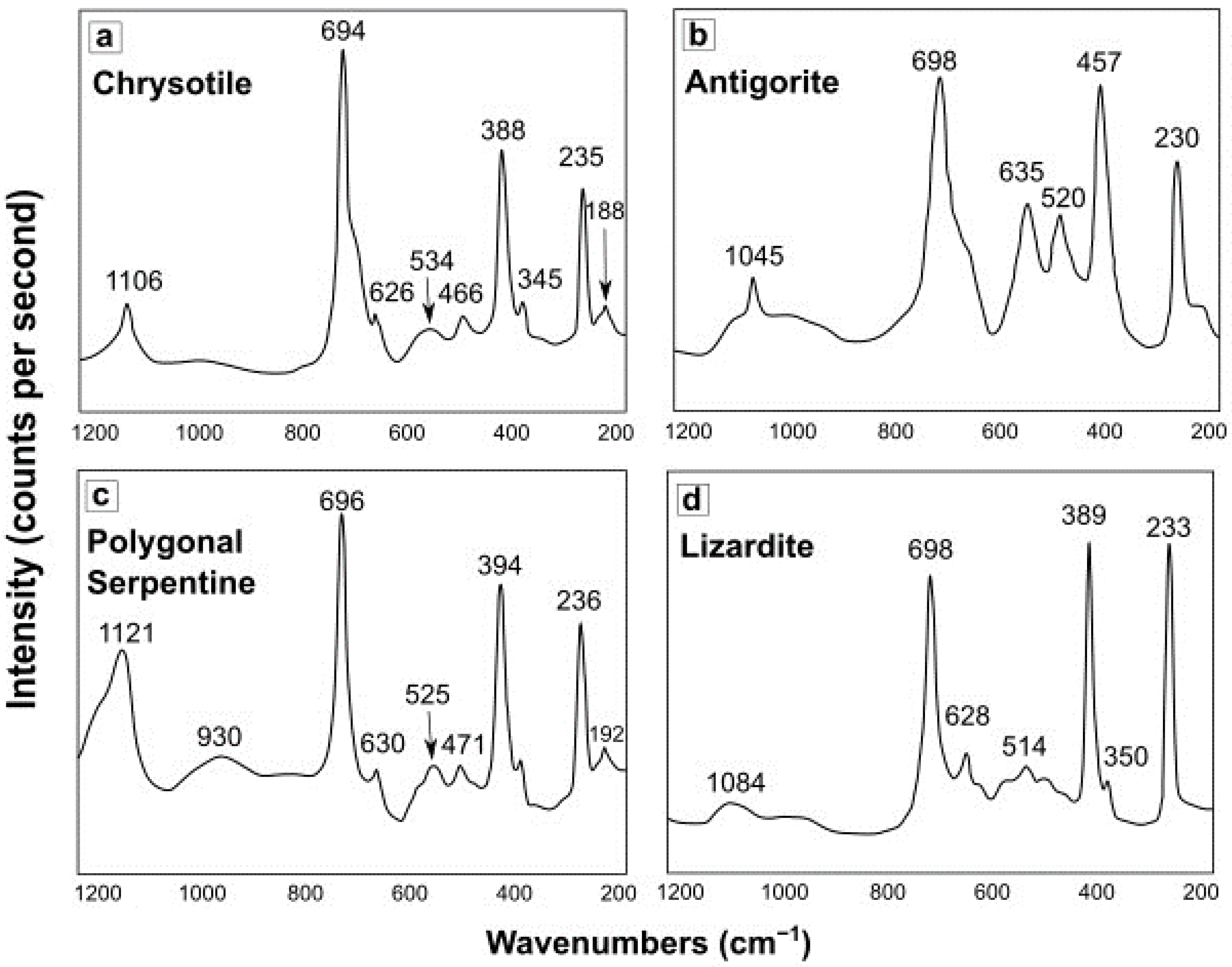
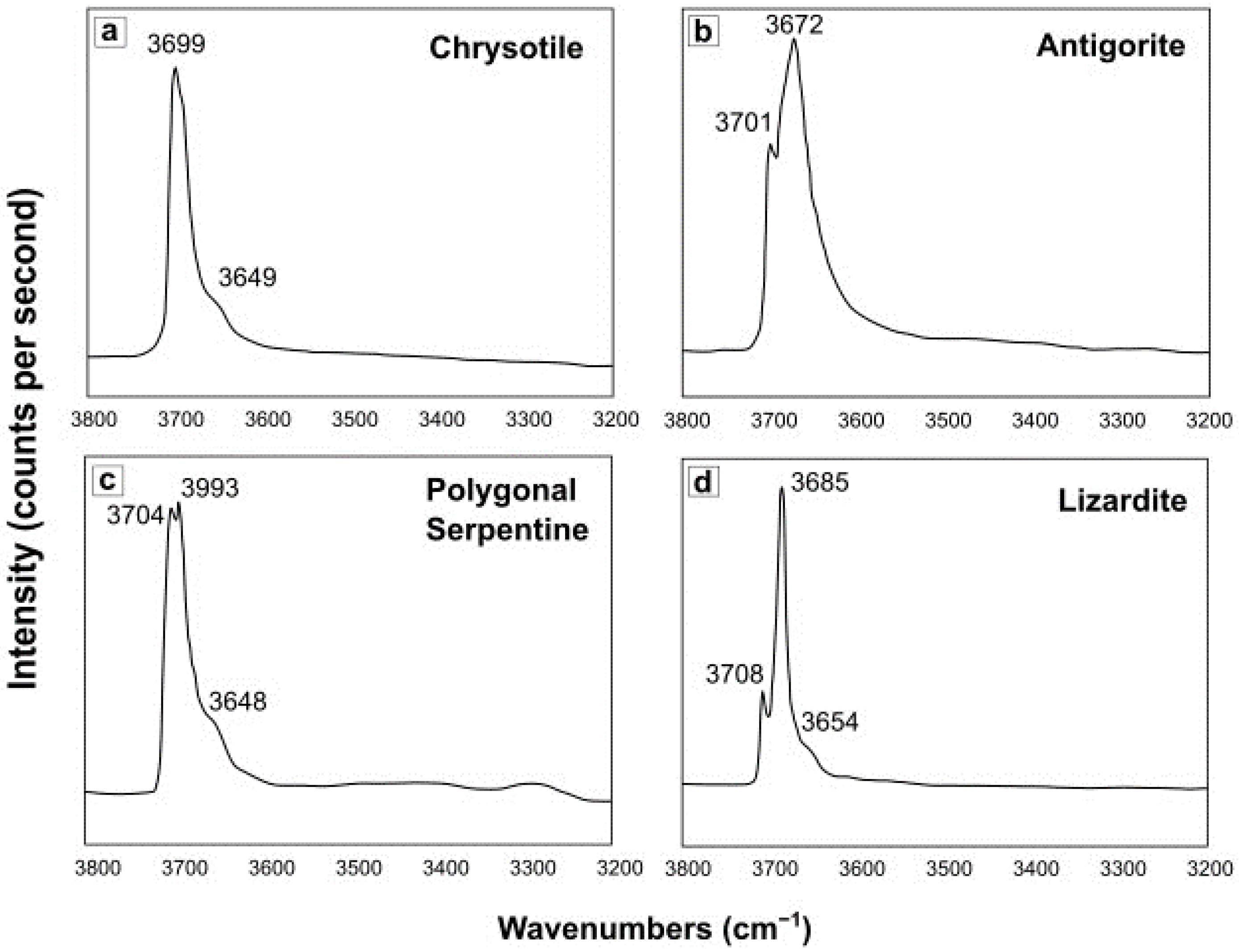

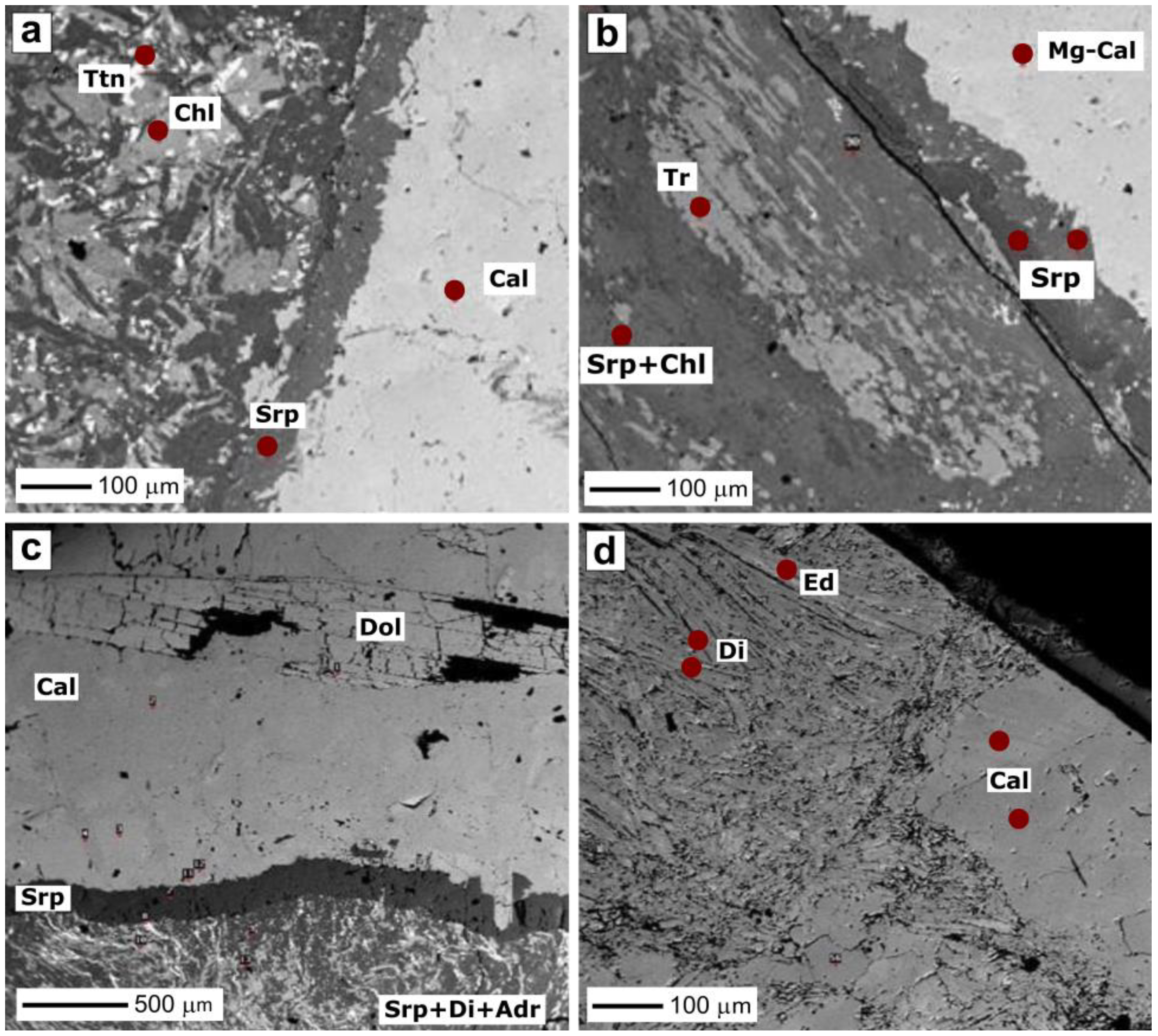

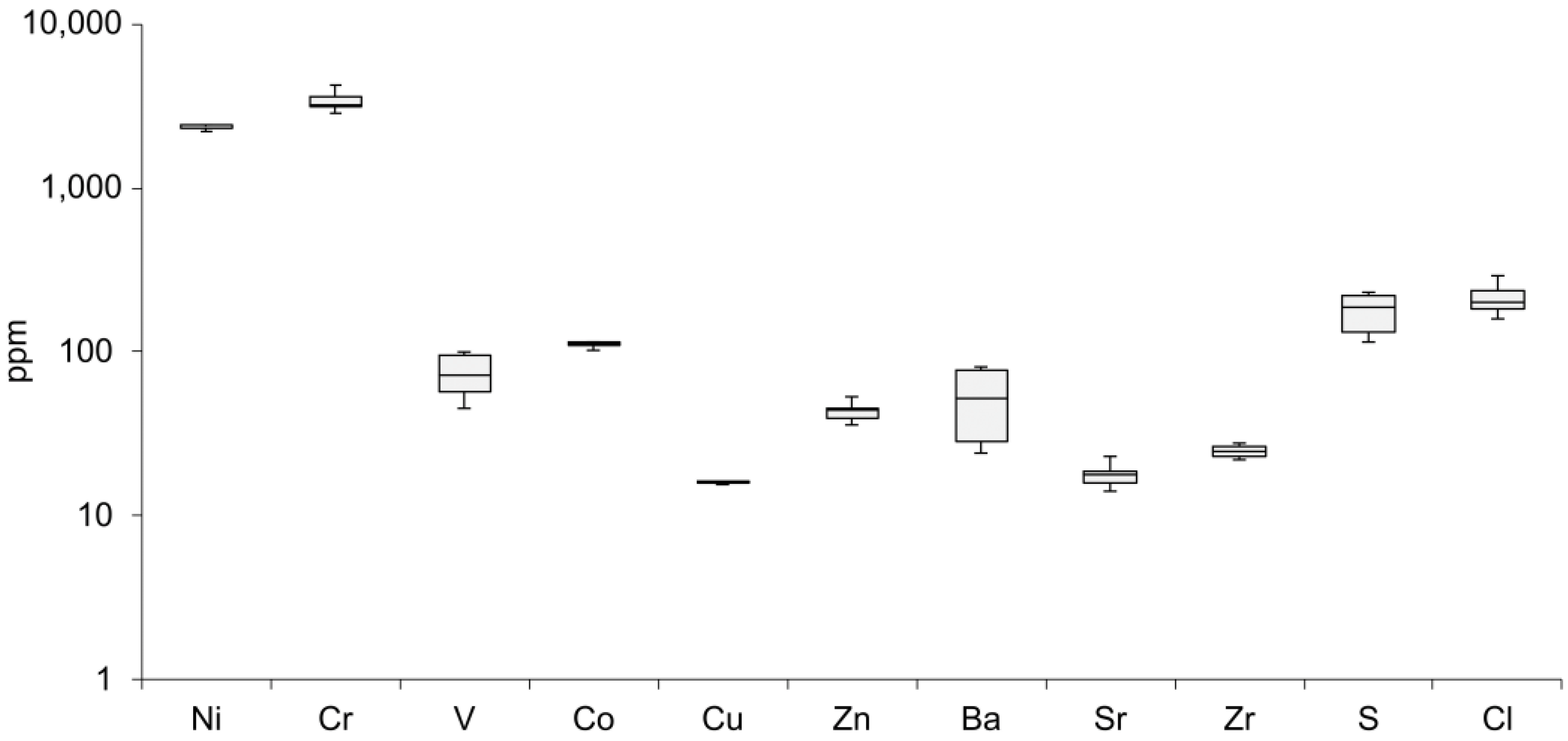
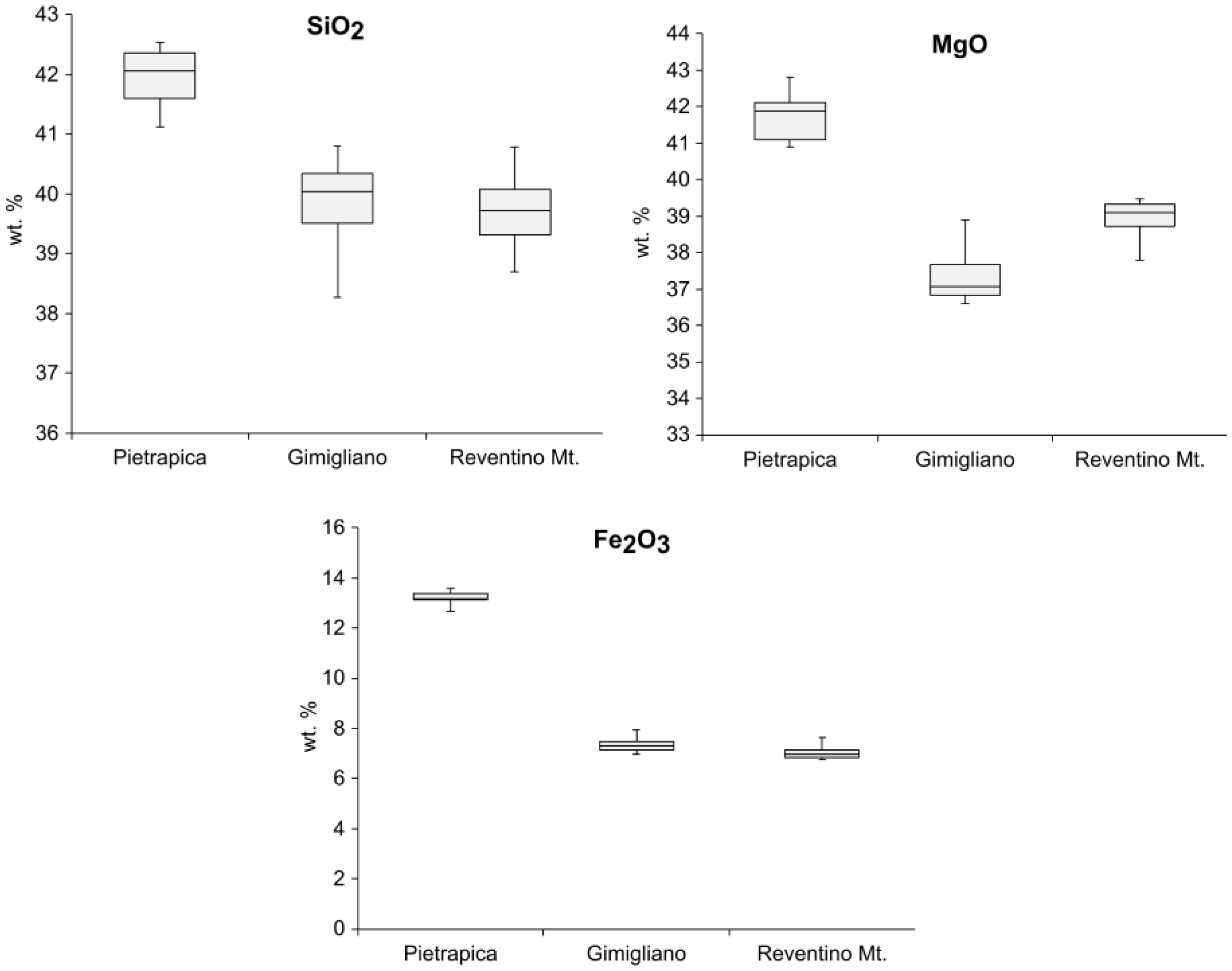
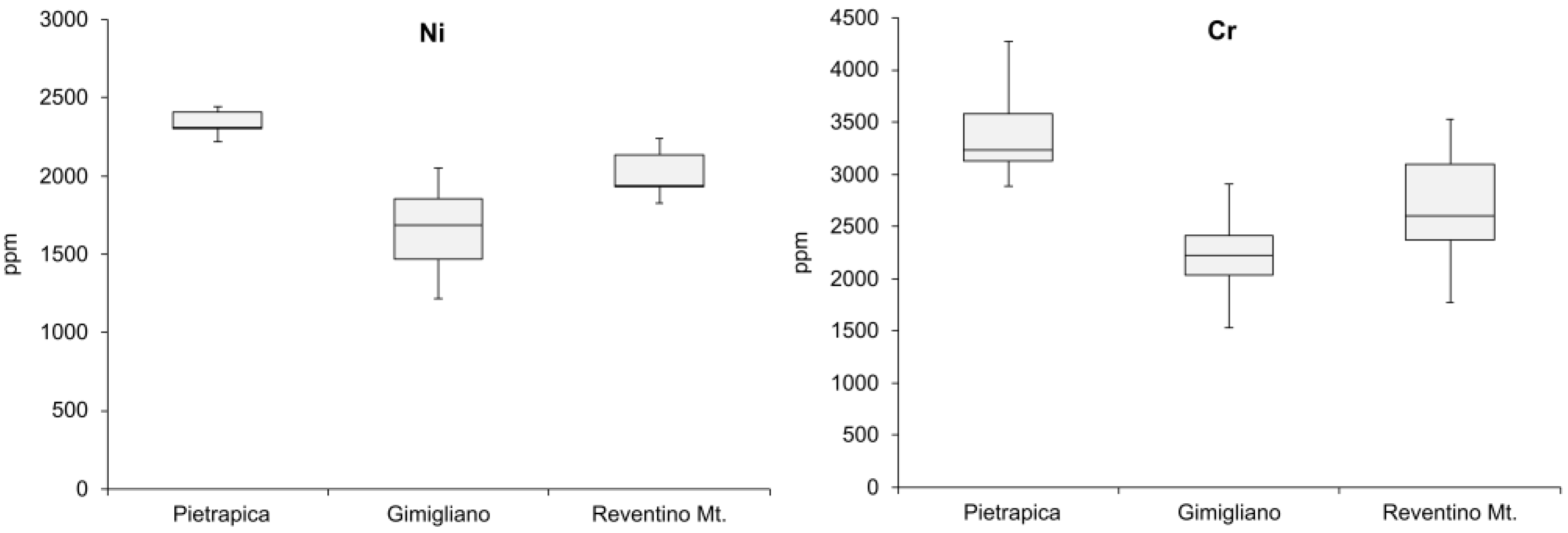

| Spot Analysis | SiO2 | MgO | Al2O3 | FeO | TiO2 | Cr2O3 | MnO | CaO | Na2O | P2O5 | NiO | Total |
|---|---|---|---|---|---|---|---|---|---|---|---|---|
| serpentine-chlorite mixed layers | ||||||||||||
| 1 | 38.850 | 35.65 | 4.48 | 5.28 | 0.032 | n.d. | 0.1 | 0.088 | n.d. | n.d. | 0.16 | 84.64 |
| 2 | 39.30 | 36.36 | 4.46 | 5.2 | 0.001 | 0.002 | 0.12 | 0.023 | n.d. | 0.018 | 0.21 | 85.69 |
| 3 | 37.180 | 34.46 | 6.90 | 4.96 | n.d. | 0.384 | 0.15 | 0.226 | 0.002 | 0.015 | 0.22 | 84.49 |
| 4 | 36.820 | 35.67 | 6.10 | 5.02 | 0.03 | 0.013 | 0.1 | 0.054 | n.d. | n.d. | n.d. | 83.8 |
| 5 | 41.210 | 36.9 | 1.70 | 4.59 | 0.039 | 0.061 | 0.06 | 0.155 | n.d. | 0.004 | 0.02 | 84.74 |
| 6 | 38.80 | 36.31 | 4.20 | 4.76 | n.d. | 0.031 | 0.08 | 0.039 | 0.006 | 0.001 | 0.06 | 84.29 |
| 7 | 39.260 | 36.39 | 4.40 | 4.83 | n.d. | 0.017 | 0.13 | 0.005 | 0.048 | 0.05 | 0.07 | 85.2 |
| 8 | 36.090 | 35.15 | 7.51 | 5.36 | n.d. | 0.059 | 0.03 | 0.003 | n.d. | 0.015 | 0.08 | 84.29 |
| 9 | 39.240 | 36.24 | 4.14 | 5.26 | 0.003 | n.d. | 0.12 | 0.077 | 0.037 | n.d. | 0.06 | 85.18 |
| 10 | 39.180 | 36.12 | 4.25 | 4.86 | 0.018 | n.d. | 0.07 | 0.071 | n.d. | n.d. | 0.03 | 84.6 |
| 11 | 39.470 | 34.99 | 4.61 | 4.98 | 0.036 | 0.222 | 0.06 | 1.270 | 0.011 | n.d. | 0.19 | 85.84 |
| 12 | 36.120 | 34.32 | 8.59 | 5.96 | 0.022 | 0.055 | 0.09 | 0.033 | 0.003 | n.d. | 0.11 | 85.3 |
| 13 | 38.160 | 33.31 | 6.49 | 4.94 | 0.47 | 0.345 | 0.04 | 0.819 | 0.022 | 0.014 | 0.02 | 84.63 |
| 14 | 39.340 | 33.07 | 5.36 | 5.28 | 0.161 | 0.238 | 0.08 | 2.10 | 0.02 | n.d. | 0.04 | 85.68 |
| 15 | 40.020 | 33.78 | 5.44 | 4.84 | 0.04 | 0.228 | 0.12 | 0.464 | n.d. | n.d. | n.d. | 84.93 |
| 16 | 38.210 | 32.91 | 7.98 | 4.71 | 0.032 | 0.376 | 0.12 | 1.210 | 0.009 | 0.025 | n.d. | 52.67 |
| 17 | 39.370 | 35.2 | 4.76 | 5.33 | n.d. | 0.07 | 0.13 | 0.071 | n.d. | 0.015 | 0.04 | 84.99 |
| 18 | 37.170 | 35.26 | 7.01 | 5.02 | 0.002 | n.d. | 0.06 | 0.033 | n.d. | n.d. | 0.03 | 84.59 |
| 19 | 39.510 | 35.38 | 5.93 | 5.03 | 0.004 | 0.015 | 0.09 | 0.062 | n.d. | n.d. | n.d. | 86.02 |
| 20 | 39.470 | 32.42 | 4.86 | 5.69 | 0.317 | 0.221 | 0.11 | 3.480 | 0.011 | 0.021 | 0.07 | 86.68 |
| 21 | 38.220 | 34.73 | 5.98 | 5.39 | 0.06 | 0.032 | 0.04 | 0.218 | 0.032 | n.d. | 0.1 | 84.8 |
| 22 | 38.730 | 35.77 | 5.69 | 5.64 | 0.002 | 0.038 | 0.03 | 0.115 | n.d. | 0.01 | 0.1 | 86.12 |
| 23 | 37.390 | 35.59 | 6.93 | 5.15 | 0.007 | 0.019 | 0.12 | 0.043 | 0.003 | n.d. | 0.06 | 85.31 |
| 24 | 38.880 | 34.03 | 5.15 | 6.09 | 0.165 | 0.059 | 0.13 | 1.220 | 0.021 | n.d. | 0.02 | 85.76 |
| 25 | 39.140 | 33.27 | 6.67 | 4.77 | n.d. | 0.317 | 0.09 | 1.880 | 0.005 | 0.015 | 0.03 | 86.19 |
| 26 | 37.780 | 36.06 | 5.83 | 5.29 | n.d. | 0.001 | 0.09 | 0.035 | 0.036 | 0.012 | 0.19 | 85.33 |
| 27 | 38.650 | 35.22 | 4.02 | 6.02 | 0.042 | n.d. | 0.05 | 0.17 | 0.03 | 0.022 | 0.18 | 84.4 |
| 28 | 37.850 | 34.48 | 6.28 | 5.49 | 0.019 | 0.026 | 0.1 | 0.104 | 0.098 | n.d. | 0.16 | 84.61 |
| 29 | 37.250 | 35.27 | 5.87 | 5.14 | n.d. | n.d. | 0.05 | 0.038 | 0.082 | n.d. | 0.16 | 83.86 |
| 30 | 37.560 | 35.53 | 6.01 | 5.26 | 0.004 | 0.005 | 0.09 | 0.048 | 0.004 | 0.07 | 0.07 | 84.65 |
| 31 | 38.060 | 36.48 | 5.41 | 4.97 | 0.003 | n.d. | 0.06 | 0.022 | 0.011 | n.d. | 0.21 | 85.22 |
| 32 | 34.080 | 33.26 | 10.98 | 7.19 | 0.002 | 0.014 | 0.06 | 0.116 | n.d. | 0.022 | 0.08 | 85.8 |
| 33 | 36.910 | 34.14 | 9.15 | 4.98 | 0.031 | 0.063 | 0.04 | 0.126 | n.d. | 0.024 | 0.04 | 85.5 |
| 34 | 37.010 | 35.54 | 8.16 | 6.12 | 0.034 | n.d. | 0.07 | 0.097 | 0.016 | 0.01 | 0.14 | 87.2 |
| 35 | 34.210 | 33.74 | 10.65 | 7.68 | n.d. | n.d. | 0.11 | 0.116 | n.d. | n.d. | 0.05 | 86.56 |
| 36 | 40.990 | 38.04 | 3.97 | 6.43 | 0.006 | n.d. | 0.06 | 0.165 | n.d. | n.d. | 0.1 | 89.76 |
| 37 | 39.640 | 36.03 | 5.11 | 6.46 | 0.12 | 0.036 | 0.16 | 0.161 | 0.084 | 0.028 | 0.08 | 87.9 |
| 38 | 37.960 | 34.89 | 7.66 | 5.47 | 0.022 | 0.059 | 0.12 | 0.127 | 0.015 | 0.022 | 0.09 | 86.43 |
| 39 | 37.130 | 35.49 | 8.31 | 4.14 | 0.152 | n.d. | 0.04 | 0.157 | n.d. | 0.009 | 0.09 | 85.52 |
| 40 | 35.860 | 34.04 | 10.36 | 6.62 | 0.018 | 0.022 | 0.01 | 0.103 | 0.032 | 0.013 | 0.01 | 87.09 |
| 41 | 35.220 | 33.25 | 10.75 | 6.81 | 0.037 | 0.074 | 0.06 | 0.108 | n.d. | n.d. | 0.01 | 86.32 |
| 42 | 35.690 | 34.84 | 9.5 | 5.22 | 0.015 | n.d. | 0.05 | 0.074 | 0.015 | 0.029 | 0.01 | 85.45 |
| 43 | 35.480 | 33.96 | 9.81 | 7.4 | 0.009 | 0.012 | 0.09 | 0.111 | n.d. | 0.004 | 0.12 | 86.99 |
| 44 | 36.620 | 35.22 | 10.19 | 5.3 | 0.018 | 0.005 | 0.1 | 0.073 | 0.028 | 0.023 | 0.01 | 87.59 |
| 45 | 36.180 | 34.39 | 9.27 | 6.34 | 0.02 | 0.03 | 0.16 | 0.077 | n.d. | 0.012 | 0.06 | 86.54 |
| 46 | 35.990 | 33.89 | 9.42 | 6.35 | 0.02 | 0.067 | 0.09 | 0.1 | 0.024 | 0.026 | 0.09 | 86.06 |
| 47 | 36.450 | 35.42 | 8.43 | 6.3 | 0.029 | 0.048 | 0.1 | 0.098 | 0.013 | 0.004 | n.d. | 86.89 |
| 48 | 36.940 | 33.94 | 9.23 | 6.54 | 0.025 | 0.043 | n.d. | 0.247 | 0.022 | 0.011 | 0.11 | 87.11 |
| 49 | 43.40 | 38.68 | 1.97 | 6.05 | 0.007 | 0.042 | 0.05 | 0.209 | n.d. | 0.016 | 0.09 | 90.51 |
| 50 | 36.210 | 34.47 | 9.36 | 5.85 | n.d. | n.d. | 0.08 | 0.088 | 0.029 | n.d. | 0.05 | 86.13 |
| 51 | 36.60 | 35.17 | 9.19 | 5.58 | n.d. | 0.027 | 0.08 | 0.049 | n.d. | n.d. | 0.08 | 86.78 |
| 52 | 34.580 | 34.08 | 10.28 | 7.51 | n.d. | n.d. | 0.03 | 0.118 | 0.001 | n.d. | 0.08 | 86.68 |
| 53 | 34.80 | 33.94 | 9.61 | 8.08 | 0.047 | n.d. | 0.02 | 0.107 | 0.001 | n.d. | 0.05 | 86.65 |
| 54 | 44.360 | 38.55 | 1.55 | 6.05 | n.d. | n.d. | 0.07 | 0.257 | 0.015 | n.d. | 0.14 | 90.99 |
| 55 | 35.690 | 34.84 | 9.5 | 5.22 | 0.015 | n.d. | 0.05 | 0.074 | 0.015 | 0.041 | 0.05 | 85.5 |
| 56 | 35.480 | 33.96 | 9.81 | 7.4 | 0.009 | 0.012 | 0.09 | 0.111 | n.d. | n.d. | n.d. | 86.87 |
| 57 | 36.340 | 35.22 | 10.19 | 5.3 | 0.018 | 0.005 | 0.1 | 0.073 | 0.028 | n.d. | n.d. | 87.28 |
| 58 | 36.180 | 34.39 | 9.27 | 6.34 | 0.02 | 0.03 | 0.16 | 0.077 | n.d. | 0.066 | 0.06 | 86.58 |
| 59 | 35.990 | 33.89 | 9.42 | 6.35 | 0.02 | 0.067 | 0.09 | 0.1 | 0.024 | n.d. | 0.1 | 86.04 |
| 60 | 36.450 | 35.42 | 8.43 | 6.3 | 0.029 | 0.048 | 0.1 | 0.098 | 0.013 | 0.025 | 0.1 | 87.02 |
| 61 | 35.940 | 33.94 | 9.28 | 6.56 | 0.025 | 0.043 | n.d. | 0.247 | 0.022 | 0.018 | 0.07 | 86.14 |
| 62 | 43.40 | 38.68 | 1.97 | 6.05 | 0.007 | 0.042 | 0.05 | 0.209 | n.d. | 0.032 | 0.08 | 90.51 |
| 63 | 36.210 | 34.47 | 9.36 | 5.58 | n.d. | n.d. | 0.08 | 0.088 | 0.029 | n.d. | 0.08 | 85.9 |
| 64 | 36.60 | 35.17 | 9.19 | 5.58 | n.d. | 0.027 | 0.08 | 0.049 | n.d. | n.d. | 0.11 | 86.8 |
| 65 | 34.580 | 34.07 | 10.28 | 7.51 | n.d. | n.d. | 0.03 | 0.118 | 0.001 | 0.017 | 0.11 | 86.72 |
| 66 | 34.80 | 33.94 | 9.61 | 8.08 | 0.047 | n.d. | 0.02 | 0.107 | 0.001 | n.d. | 0.04 | 86.65 |
| 67 | 44.360 | 38.55 | 1.55 | 6.05 | n.d. | n.d. | 0.07 | 0.257 | 0.015 | 0.015 | 0.07 | 90.93 |
| 68 | 33.420 | 32.59 | 11.91 | 7.14 | 0.059 | 0.493 | 0.02 | 0.276 | n.d. | 0.009 | 0.06 | 85.97 |
| 69 | 33.580 | 32.82 | 12.57 | 6.82 | 0.023 | 0.066 | 0.14 | 0.047 | 0.031 | 0.026 | 0.03 | 86.16 |
| 70 | 32.430 | 30.03 | 15.49 | 8.03 | n.d. | 0.049 | 0.16 | 0.04 | n.d. | 0.04 | 0.07 | 86.33 |
| 71 | 35.750 | 32.57 | 9.59 | 6.51 | 1.530 | 0.086 | 0.17 | 1.290 | 0.002 | n.d. | 0.08 | 87.58 |
| 72 | 36.630 | 33.89 | 1.13 | 6.24 | 0.011 | 0.027 | 0.02 | 0.154 | n.d. | 0.01 | 0.09 | 78.2 |
| 73 | 34.850 | 32.78 | 9.98 | 7.69 | n.d. | n.d. | 0.05 | 0.597 | n.d. | 0.031 | 0.06 | 86.04 |
| 74 | 37.120 | 34.37 | 8.4 | 5.43 | 0.052 | 0.038 | 0.02 | 0.067 | 0.026 | n.d. | 0.05 | 85.56 |
| 75 | 33.440 | 31.61 | 12.69 | 7.53 | 0.001 | n.d. | 0.02 | 0.109 | 0.018 | n.d. | 0.06 | 85.47 |
| 76 | 34.90 | 34.66 | 9.5 | 6.91 | 0.008 | 0.031 | 0.09 | 0.176 | 0.009 | 0.01 | 0.02 | 86.31 |
| 77 | 36.920 | 35.21 | 8.66 | 5.85 | 0.029 | 0.077 | 0.11 | 0.094 | 0.003 | 0.016 | 0.04 | 87.02 |
| 78 | 35.0 | 32.07 | 11.73 | 6.87 | 0.012 | 0.145 | 0.16 | 0.685 | 0.018 | 0.028 | 0.02 | 86.74 |
| 79 | 40.290 | 37.61 | 3.39 | 5.97 | 0.026 | n.d. | 0.06 | 0.145 | 0.018 | n.d. | 0.04 | 87.55 |
| 80 | 36.470 | 36.81 | 9.04 | 4.77 | 0.006 | 0.024 | 0.05 | 0.124 | 0.016 | 0.005 | 0.01 | 87.33 |
| 81 | 36.610 | 35.43 | 8.68 | 4.94 | 0.046 | n.d. | 0.05 | 0.079 | 0.016 | 0.024 | 0.05 | 85.92 |
| Anphiboles | ||||||||||||
| 1 | 44.26 | 24.92 | 4.25 | 4.33 | 0.241 | 0.204 | 0.1 | 11.63 | 0.057 | 0.014 | 0.12 | 90.12 |
| 2 | 40.68 | 12.91 | 1.04 | 1.9 | n.d. | 0.022 | 0.07 | 31.78 | 0.082 | 0.017 | 0.01 | 88.52 |
| 3 | 40.97 | 23.13 | 8.41 | 2.61 | 0.016 | 0.029 | 0.09 | 13.05 | 0.21 | 0.026 | 0.06 | 88.6 |
| 4 | 43.81 | 28.9 | 3.58 | 3.86 | 0.018 | 0.137 | 0.08 | 8.72 | 0.033 | 0.005 | 0.09 | 89.23 |
| 5 | 47.59 | 14.72 | 10.81 | 1.18 | 0.017 | 0.01 | 0.1 | 21.81 | 0.149 | 0.009 | n.d. | 96.4 |
| 6 | 54.58 | 23.1 | 2.79 | 3.92 | 0.158 | 0.224 | 0.14 | 11.42 | 1 | 0.02 | 0.11 | 97.65 |
| 7 | 57.39 | 23.41 | 0.47 | 3.14 | 0.011 | 0.007 | 0.09 | 13.57 | 0.09 | n.d. | 0.09 | 98.27 |
| 8 | 55.67 | 24.4 | 1.55 | 2.47 | 0.059 | 0.092 | 0.05 | 12.84 | 0.459 | 0.022 | 0.05 | 97.66 |
| 9 | 52.04 | 22.6 | 5.28 | 3.23 | 0.433 | 0.425 | 0.03 | 11.95 | 1.18 | 0.057 | 0.08 | 97.3 |
| 10 | 53.73 | 23.23 | 3.54 | 3.06 | 0.268 | 0.486 | 0.12 | 12.06 | 1.14 | 0.013 | 0.08 | 97.72 |
| 11 | 57.54 | 23.52 | 1.36 | 2.66 | 0.075 | 0.009 | 0.08 | 12.27 | 0.358 | 0.017 | 0.05 | 97.94 |
| 12 | 51.65 | 21.81 | 5.48 | 2.87 | 0.482 | 0.502 | 0.03 | 12.42 | 1.29 | 0.014 | 0.14 | 96.69 |
| 13 | 55.26 | 20.99 | 1.87 | 7.06 | 0.065 | 0.006 | 0.17 | 9.68 | 1.99 | 0.012 | 0.05 | 97.15 |
| 14 | 55.01 | 23.62 | 2.5 | 2.4 | 0.059 | 0.225 | 0.08 | 12.52 | 0.813 | 0.023 | n.d. | 97.25 |
| 15 | 57.33 | 23.44 | n.d. | 2.01 | n.d. | n.d. | 0.02 | 13.65 | 0.07 | 0.013 | n.d. | 96.54 |
| Cr-Spinel | 0 | |||||||||||
| 1 | 0.03 | 14.06 | 30.53 | 15.59 | 0.12 | 36.39 | 0.08 | n.d. | 0.01 | 0.009 | 0.03 | 96.851 |
| 2 | 2.57 | 2.75 | 1.56 | 25.77 | 0.43 | 28.98 | 5.13 | 0.05 | 0.02 | 0.026 | 0.05 | 67.340 |
| 3 | 0.03 | 14.69 | 29.68 | 14.47 | 0.11 | 37.27 | 0.1 | n.d. | n.d. | 0.04 | 0.03 | 96.417 |
| 4 | 3.28 | 3.59 | 2.24 | 25.25 | 0.47 | 32.3 | 5.41 | 0.06 | 0.04 | n.d. | 0.05 | 72.685 |
| 5 | 4.34 | 5.35 | 3.04 | 24.66 | 0.46 | 29.86 | 4.88 | 0.09 | 0.05 | 0.01 | 0.02 | 72.759 |
| 6 | 0.03 | 13.96 | 30.4 | 15.69 | 0.13 | 35.96 | 0.11 | 0.02 | n.d. | 0.031 | 0.06 | 96.387 |
| 7 | 0.03 | 14.08 | 31.39 | 15.81 | 0.13 | 35.52 | 0.06 | 0.01 | n.d. | n.d. | 0.06 | 97.085 |
| 8 | 4.21 | 4.76 | 1.85 | 24.89 | 0.51 | 30.77 | 5.33 | 0.07 | 0.07 | n.d. | 0.05 | 72.507 |
| 9 | 0.03 | 13.95 | 30.89 | 15.94 | 0.14 | 36.03 | 0.11 | 0.01 | 0.01 | 0.01 | 0.05 | 97.167 |
| 10 | 3.83 | 4.24 | 1.9 | 24.23 | 0.45 | 29.11 | 4.91 | 0.28 | 0.06 | 0.016 | 0.08 | 69.107 |
| 11 | 0.04 | 14.2 | 30.07 | 15.06 | 0.14 | 35.44 | 0.09 | n.d. | n.d. | 0.028 | 0.04 | 95.111 |
| 12 | 3.98 | 4.38 | 1.61 | 24.92 | 0.42 | 29.43 | 5.03 | 0.06 | 0.04 | n.d. | 0.05 | 69.920 |
| Clynopyroxene | 0 | |||||||||||
| 1 | 54.47 | 17.37 | 0.241 | 0.880 | 0.048 | n.d. | 0.05 | 26 | 0.009 | 0.024 | 0.02 | 98.95 |
| 2 | 54.63 | 17.28 | 0.456 | 2.20 | 0.1 | 0.052 | 0.17 | 24 | 0.035 | 0.057 | n.d. | 99.4 |
| 3 | 52.14 | 17.06 | 1.040 | 3.80 | 0.111 | 0.156 | 0.3 | 23.57 | 0.108 | n.d. | 0.01 | 98.3 |
| 4 | 54.43 | 17.76 | 0.035 | 1.360 | 0.045 | 0.043 | 0.25 | 25 | n.d. | 0.118 | n.d. | 99.48 |
| 5 | 53.35 | 17.68 | 0.958 | 1.250 | 0.006 | 0.015 | 0.15 | 23.64 | 0.102 | n.d. | 0.01 | 97.17 |
| 6 | 54.45 | 17.10 | 0.259 | 1.30 | 0.006 | n.d. | 0.06 | 25.34 | 0.057 | 0.001 | 0.04 | 98.62 |
| 7 | 52.41 | 14.990 | 1.60 | 1.150 | n.d. | 0.003 | 0.12 | 24 | 0.051 | 0.038 | 0.05 | 94.88 |
| 8 | 53.06 | 16.510 | 1.590 | 2.30 | 0.017 | 0.016 | 0.18 | 25 | 0.145 | 0.022 | n.d. | 98.36 |
| 9 | 53.45 | 16.910 | 0.858 | 1.760 | 0.025 | n.d. | 0.08 | 25 | 0.091 | 0.065 | 0.05 | 98.12 |
| 10 | 53.37 | 17.50 | 0.747 | 1.340 | n.d. | 0.024 | 0.04 | 25 | 0.071 | 0.028 | 0.06 | 97.89 |
| 11 | 49.36 | 16.880 | 1.750 | 1.660 | 0.003 | n.d. | 0.09 | 24 | 0.113 | 0.032 | 0.02 | 93.96 |
| 12 | 54.12 | 16.72 | 0.486 | 1.850 | 0.012 | 0.013 | 0.12 | 25 | 0.076 | 0.015 | n.d. | 98.64 |
| 13 | 52.95 | 16.70 | 0.785 | 1.960 | 0.012 | 0.006 | 0.12 | 24.940 | 0.062 | 0.037 | 0.05 | 97.62 |
| 14 | 54.29 | 17.10 | 0.382 | 1.430 | 0.021 | 0.003 | 0.14 | 26 | 0.102 | 0.032 | 0.03 | 99.02 |
| 15 | 53.87 | 16.99 | 0.388 | 2.850 | 0.023 | 0.007 | 0.12 | 25 | 0.056 | 0.062 | 0.01 | 99.78 |
| 16 | 54.59 | 17.980 | 0.027 | 1.060 | n.d. | n.d. | 0.1 | 26 | n.d. | 0.018 | 0.02 | 99.48 |
| 17 | 53.32 | 17.060 | 0.56 | 2.10 | 0.052 | n.d. | 0.31 | 24 | 0.055 | 0.025 | n.d. | 97.8 |
| 18 | 53.82 | 16.660 | 0.143 | 1.940 | 0.033 | 0.01 | 0.28 | 26 | n.d. | 0.032 | n.d. | 98.59 |
| Talc | 0 | |||||||||||
| 1 | 59.4 | 29.65 | 0.52 | 2.65 | 0.024 | 0.006 | n.d. | 0.177 | 0.033 | n.d. | 0.14 | 92.6 |
| 2 | 59.26 | 29.76 | 0.556 | 2.63 | 0.05 | n.d. | 0.02 | 0.164 | 0.059 | n.d. | 0.08 | 92.58 |
| 3 | 60.01 | 28.93 | 0.537 | 2.56 | 0.009 | 0.005 | n.d. | 0.22 | 0.039 | 0.025 | 0.13 | 92.47 |
| 4 | 59.58 | 30.09 | 0.653 | 3.78 | n.d. | n.d. | 0.03 | 0.262 | 0.077 | n.d. | 0.07 | 94.54 |
| 5 | 60.24 | 29.69 | 0.487 | 2.41 | 0.019 | n.d. | n.d. | 0.138 | 0.055 | n.d. | 0.12 | 93.16 |
| 6 | 59.45 | 28.78 | 0.637 | 2.53 | n.d. | n.d. | 0.01 | 0.161 | 0.098 | 0.008 | 0.07 | 91.74 |
| 7 | 60.63 | 28.99 | 0.573 | 2.72 | 0.012 | n.d. | n.d. | 0.159 | 0.066 | n.d. | 0.11 | 93.26 |
| 8 | 59.86 | 28.17 | 0.65 | 2.5 | n.d. | 0.01 | n.d. | 0.204 | 0.363 | 0.018 | 0.03 | 91.8 |
| 9 | 60.42 | 27.97 | 0.42 | 2.53 | 0.012 | 0.02 | n.d. | 0.166 | 0.088 | 0.001 | 0.06 | 91.69 |
| 10 | 60.53 | 29.2 | 0.265 | 3.3 | n.d. | 0.01 | n.d. | 0.12 | 0.076 | 0.006 | 0.05 | 93.56 |
| 11 | 59.61 | 30.28 | 0.581 | 2.77 | n.d. | n.d. | 0.05 | 0.159 | 0.082 | 0.023 | 0.06 | 93.61 |
| 12 | 59.14 | 29.56 | 0.566 | 2.63 | n.d. | 0.023 | 0.04 | 0.224 | 0.053 | 0.007 | 0.11 | 92.35 |
| 13 | 58.18 | 28.48 | 0.35 | 2.22 | 0.035 | 0.014 | 0.02 | 0.106 | 0.061 | 0.003 | 0.15 | 89.62 |
| 14 | 58.26 | 27.26 | 0.539 | 2.82 | 0.007 | 0.081 | n.d. | 0.175 | 0.031 | 0.036 | 0.01 | 89.22 |
| 15 | 58.58 | 29.34 | 0.601 | 3.45 | 0.034 | n.d. | 0.01 | 0.227 | 0.101 | 0.027 | 0.1 | 92.47 |
| 16 | 60.33 | 28.83 | 0.651 | 2.83 | n.d. | n.d. | n.d. | 0.207 | 0.052 | 0.001 | 0.11 | 93.01 |
| 17 | 61.63 | 27.81 | 0.377 | 2.75 | 0.008 | n.d. | n.d. | 0.078 | 0.101 | 0.004 | 0.07 | 92.83 |
| 18 | 59.22 | 29.89 | 0.337 | 2.77 | 0.002 | n.d. | n.d. | 0.173 | 0.042 | 0.039 | 0.1 | 92.57 |
| 19 | 60.62 | 29.82 | 0.255 | 3.34 | 0.013 | 0.032 | 0.01 | 0.111 | 0.037 | n.d. | 0.16 | 94.4 |
| 20 | 58.79 | 27.33 | 0.42 | 3.37 | n.d. | n.d. | 0.03 | 0.232 | 0.041 | 0.004 | 0.11 | 90.33 |
| 21 | 60.63 | 28.47 | 0.524 | 2.89 | 0.027 | n.d. | n.d. | 0.105 | 0.034 | n.d. | n.d. | 92.68 |
| 22 | 61.43 | 28.58 | 0.554 | 2.93 | n.d. | n.d. | n.d. | 0.114 | 0.064 | 0.01 | 0.1 | 93.79 |
| 23 | 60.43 | 29.43 | 0.39 | 2.66 | n.d. | n.d. | 0.02 | 0.127 | 0.058 | n.d. | 0.06 | 93.17 |
| Titanite and magnetite | 0 | |||||||||||
| 1 | 1.70 | 1.20 | 0.79 | 80.71 | n.d. | 0.217 | 0.07 | 0.185 | 0.016 | 0.047 | 0.02 | 84.96 |
| 2 | 0.616 | 0.324 | 0.13 | 84.14 | 0.066 | 0.141 | 0.04 | 0.231 | n.d. | 0.053 | 0.03 | 85.78 |
| 3 | 0.759 | 0.492 | 0.59 | 77.23 | 0.138 | 7.1 | 0.47 | 0.086 | 0.091 | 0.165 | 0.04 | 87.16 |
| 4 | 0.874 | 0.428 | 4 | 80.8 | 0.124 | 0.303 | 0.06 | 0.534 | 0.077 | 0.053 | 0.07 | 87.79 |
| d.l. | PP1 | PP2 | PP3 | PP4 | PP5 | PP6 | |
|---|---|---|---|---|---|---|---|
| % | |||||||
| SiO2 | 0.01 | 41.8 | 41.54 | 41.12 | 42.38 | 42.53 | 42.32 |
| TiO2 | 0.001 | 0.18 | 0.1 | 0.22 | 0.08 | 0.13 | 0.09 |
| Al2O3 | 0.001 | 2.11 | 1.4 | 1.22 | 1.95 | 1.09 | 1.8 |
| Fe2O3(T) | 0.01 | 13.24 | 13.45 | 13.59 | 13.1 | 12.65 | 13.14 |
| MnO | 0.001 | 0.11 | 0.12 | 0.12 | 0.13 | 0.11 | 0.12 |
| MgO | 0.01 | 40.9 | 42.8 | 42.14 | 40.9 | 41.73 | 42.01 |
| CaO | 0.01 | 1.52 | 0.3 | 1.28 | 0.79 | 1.24 | 0.06 |
| K2O | 0.01 | 0.01 | 0.01 | 0.02 | 0.01 | 0.02 | 0.01 |
| Total | 99.87 | 99.54 | 99.71 | 99.34 | 99.5 | 99.55 | |
| LOI | 11.21 | 11.38 | 11.55 | 10.89 | 11.12 | 10.97 | |
| ppm | |||||||
| Ni | 20 | 2220.54 | 2440.53 | 2312.42 | 2297.15 | 2313.03 | 2445.98 |
| Cr | 20 | 2890 | 3104 | 5355 | 3687 | 3284 | 3184 |
| V | 5 | 98 | 45 | 56 | 100 | 58 | 86 |
| Co | 1 | 112.86 | 113.68 | 107.64 | 114.19 | 111.82 | 99.54 |
| Cu | 10 | 15.79 | 15.2 | 16.12 | 15.94 | 16.25 | 15.79 |
| Zn | 30 | 43.76 | 54.2 | 35.77 | 44.34 | 44.85 | 37.76 |
| Ba | 5 | 30 | 75 | 24 | 81 | 77 | 28 |
| Sr | 2 | 46 | 19 | 18 | 14 | 15 | 18 |
| Zr | 4 | 24 | 27 | 25 | 28 | 23 | 22 |
| S | 5 | 125 | 220 | 232 | 155 | 217 | 114 |
| Cl | 5 | 184 | 245 | 290 | 187 | 159 | 217 |
Disclaimer/Publisher’s Note: The statements, opinions and data contained in all publications are solely those of the individual author(s) and contributor(s) and not of MDPI and/or the editor(s). MDPI and/or the editor(s) disclaim responsibility for any injury to people or property resulting from any ideas, methods, instructions or products referred to in the content. |
© 2023 by the authors. Licensee MDPI, Basel, Switzerland. This article is an open access article distributed under the terms and conditions of the Creative Commons Attribution (CC BY) license (https://creativecommons.org/licenses/by/4.0/).
Share and Cite
Rizzo, G.; Buccione, R.; Dichicco, M.; Punturo, R.; Mongelli, G. Petrography, Geochemistry and Mineralogy of Serpentinite Rocks Exploited in the Ophiolite Units at the Calabria-Basilicata Boundary, Southern Apennine (Italy). Fibers 2023, 11, 81. https://doi.org/10.3390/fib11100081
Rizzo G, Buccione R, Dichicco M, Punturo R, Mongelli G. Petrography, Geochemistry and Mineralogy of Serpentinite Rocks Exploited in the Ophiolite Units at the Calabria-Basilicata Boundary, Southern Apennine (Italy). Fibers. 2023; 11(10):81. https://doi.org/10.3390/fib11100081
Chicago/Turabian StyleRizzo, Giovanna, Roberto Buccione, Marilena Dichicco, Rosalda Punturo, and Giovanni Mongelli. 2023. "Petrography, Geochemistry and Mineralogy of Serpentinite Rocks Exploited in the Ophiolite Units at the Calabria-Basilicata Boundary, Southern Apennine (Italy)" Fibers 11, no. 10: 81. https://doi.org/10.3390/fib11100081
APA StyleRizzo, G., Buccione, R., Dichicco, M., Punturo, R., & Mongelli, G. (2023). Petrography, Geochemistry and Mineralogy of Serpentinite Rocks Exploited in the Ophiolite Units at the Calabria-Basilicata Boundary, Southern Apennine (Italy). Fibers, 11(10), 81. https://doi.org/10.3390/fib11100081








